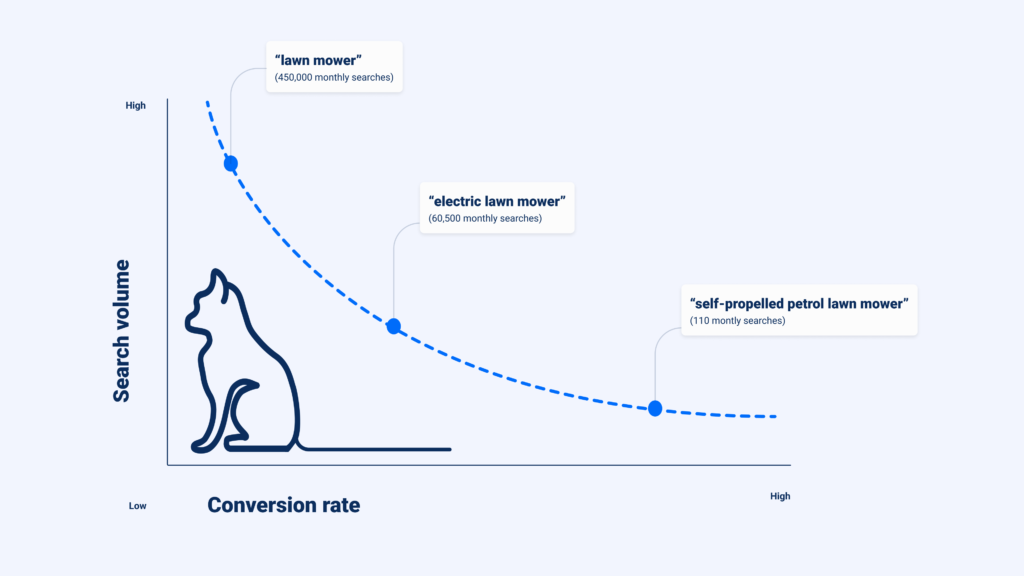When optimizing web content, it is common knowledge that keywords still matter. The competition for ranking for single keywords is stringent, with digital content getting published at an astonishing rate. With every shift in Google’s algorithms, new rules define how to rank content better, and brands who initially thought that effectively placing their targeted keyword as frequently as possible would suffice have found that it isn’t enough.
Long-tail keywords are not new when it comes to improving content and responding to user queries. Google introduced long-tail keywords and semantic search as vital SEO factors nearly a decade ago. Today, these factors have gone beyond SEO to any aspect of conversational experiences online. Knowledge bases, website search or even chatbots interpret words and try to deliver results to users- But, the more complex the wording, the harder it is to provide the right answers. Users however are using more conversational tones and wording when making searches and the need to be able to understand and answer long-tail queries is higher than ever.
Search tools and conversational platforms facilitate user inquiries, but they often are based on basic keyword searches, and they often pay scant attention to long-tail queries. Consequently, opportunities are being lost.
But just how important are long-tail queries, and what role does semantic search play in this?

What are long-tail search queries?
Long-tail search queries are longer and more targeted keyword phrases that users usually make either when:
- asking a very concise question in which they add a lot of detail, or
- using voice search, as verbally, we tend to express ourselves including many more words.
In SEO, long-tail keywords have low search volume, low competition, but high conversion rates. These queries are aligned with the final stages of a purchase funnel.
We call them long-tail because when they are represented on a graph by their search volumes, they are on the long tail end of the search demand curve. In fact, the term long-tail keyword comes from the book The Long Tail by Chris Anderson. In this book, Anderson shows that even where there is a small market, the vastness of the internet can still make your niche keyword profitable.

Why are long-tail keywords important?
Nowadays, web users interact with any given website’s search the same way they’d interact with the Google search bar. This means that only 20% of web search queries are formulated using short keywords, while 80% of search queries on websites are made of 3 or more words, aka long-tail keywords.
Being used to finding information on Google using natural language rather than only targeted keywords, website visitors are now expecting the sites they visit to offer the same level of understanding. Online businesses need to step up their search game and be able to provide the right answers to any user query, regardless of its complexity or length, rather than just return a “no result” page, increasing frustration among users.
The premise is quite clear: search technology must be able to decipher long-tail keywords in order to understand what customers are really saying and show them what they want.
The next step: Long-tail NLP and semantic search
What do long-tail keywords and Natural Language Processing have in common? Well, NLP technology is simply the best way to decipher the real intent and meaning behind long-tail keywords. Humans have different ways of expressing what they want, as we do not speak in binary. The same word, or phrase, can have multiple meanings and can be expressed in different ways.

Thanks to NLP technology, a website search engine can understand the meaning behind complex search queries including long-tail keywords, and provide adequate answers to web users. This evolution from basic keyword search to a more intrinsic intent-focused search is known as semantic search.
What is the difference between keyword-based search and semantic search?
With keyword search, you get what you ask for. So, if a word is a homograph and has different meanings but is written in the same way, it will appear in your search. There will be no differentiation between a bat that is an animal and a bat that is sports equipment. Also, if relevant content appears on winged mammals, a strict keyword search won’t find it and cannot identify causal relations between words.
Semantic search looks into the meanings of words and considers the user’s intent to deliver information and concepts that haven’t been explicitly written into a query.
Therefore, when enterprises want to delve into providing a user experience that relates to what they want to say, be it through conversational platforms, chatbots or SEO keyword strategies, using semantic search delivers better insights into what users are seeking.
Learn more: Download Inbenta Search product datasheet
Semantic Clustering: enriching customer experience by identifying content gaps
How can you prevent customers from feeling frustrated when they do not receive an adequate search result for a query they made? Semantic Clustering groups semantically equivalent search queries involving words, phrases and sentences into clusters based on meaning.
Inbenta’s Semantic Clustering can locate and group a collection of similar, unanswered questions to provide a holistic view to help businesses fill their knowledge gap. Users can also detect where customers have had failed inquiries where they didn’t receive a satisfactory response and alert the company to develop material that answers these questions, reducing the use of support tickets and increasing customer satisfaction.
Semantic clustering can be used to optimize web search and is also utilized by the best AI chatbots to improve the quality of conversations and deliver an interactive customer experience.
Why you should use NLP and semantic search on your websites
Provide answers to all relevant queries
As you now understand, using a semantic search engine on your website that’s powered by NLP technology ensures that it understands all the relevant queries that are being made by users, whether they’re made of short or long-tail keywords.
Understanding all sorts of queries, no matter how they’re formulated, means the search tool is then able to answer these queries, offering highly correct result rates to your website visitors.
Support tool for customers and agents alike
With Inbenta Search, users can leverage semantic search capabilities, Inbenta’s Symbolic AI and NLP technology with data pulled across customer relationship tools such as Salesforce and Zendesk to better understand customer requests and deliver prompt, centralized and relevant answers that deflect time and resources from customer support teams.
Support agents can also benefit from such a tool, using it internally to help them find information or answers to support queries.
Enhance your web visitor’s journey
By analyzing long-tail keywords to deliver accurate search results, Inbenta Search helps customers save time looking for the right information. This improves customer experience, NPS scores and drives more sales by boosting conversions.
Learn how integrating Inbenta Search into your website can help your business thrive.
The post How Can Semantic Search Manage Long-tail Queries? appeared first on Inbenta.
- "
- accurate
- across
- agents
- AI
- algorithms
- All
- among
- animal
- answer
- attention
- being
- benefit
- BEST
- Beyond
- boosting
- brands
- business
- businesses
- call
- capabilities
- centralized
- collection
- Common
- company
- competition
- complex
- considers
- content
- conversations
- Conversion
- conversions
- curve
- customer
- customer experience
- Customer satisfaction
- Customer Support
- Customers
- data
- decade
- delivers
- Demand
- detail
- develop
- different
- digital
- Engine
- equipment
- evolution
- experience
- Experiences
- expressed
- factors
- finding
- First
- found
- game
- gap
- getting
- Google Search
- Group
- Group’s
- help
- helps
- High
- higher
- highly
- How
- How To
- However
- HTTPS
- Humans
- identify
- identifying
- important
- improve
- Including
- increasing
- information
- insights
- intent
- interactive
- Internet
- IT
- knowledge
- known
- language
- Level
- Leverage
- Long
- looking
- made
- Making
- manage
- Market
- material
- Matter
- meaning
- means
- more
- multiple
- Natural
- offer
- offering
- online
- opportunities
- Optimize
- optimizing
- order
- Pay
- phrases
- placing
- Platforms
- Play
- possible
- Product
- profitable
- provide
- providing
- purchase
- quality
- question
- Rates
- receive
- reducing
- relations
- relationship
- relevant
- requests
- Resources
- response
- Results
- return
- rules
- sales
- satisfaction
- Search
- search engine
- seeking
- shift
- Short
- similar
- Sites
- small
- So
- Sports
- strategies
- support
- targeted
- Technology
- Through
- tickets
- time
- today
- tool
- tools
- understand
- understanding
- use
- users
- usually
- View
- visitors
- vital
- Voice
- volume
- volumes
- web
- Website
- websites
- What
- whether
- while
- WHO
- words
- would
- Zendesk













